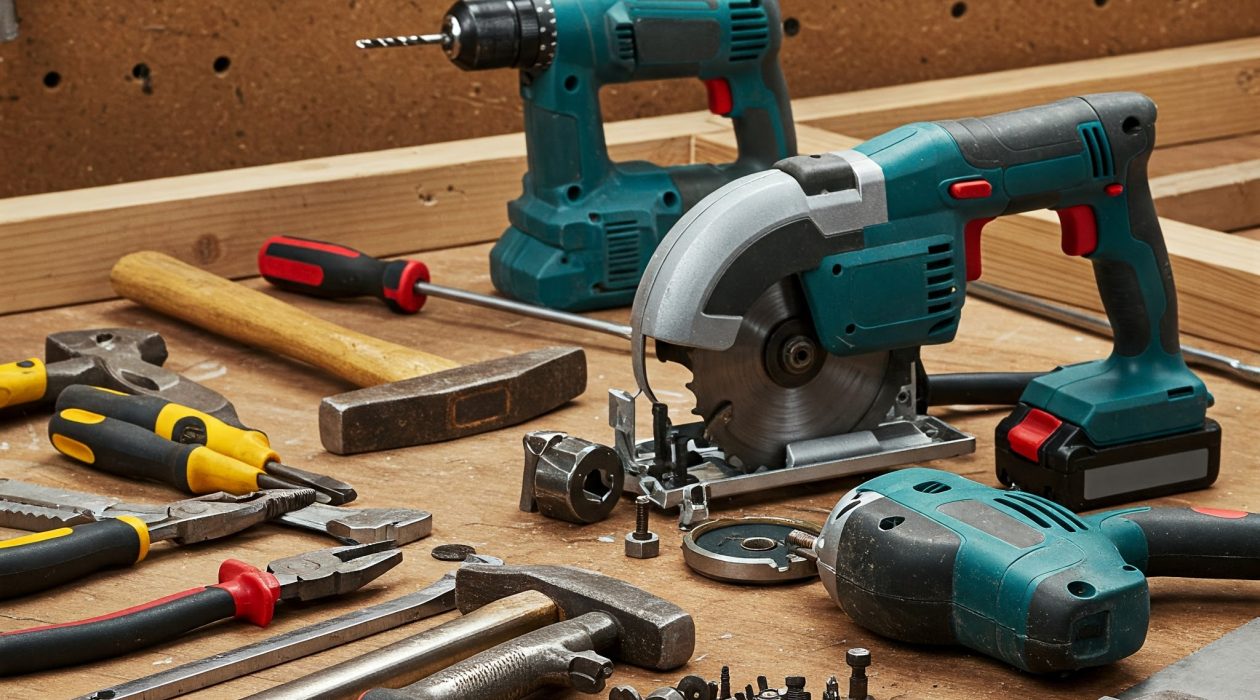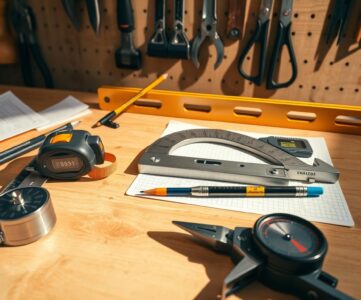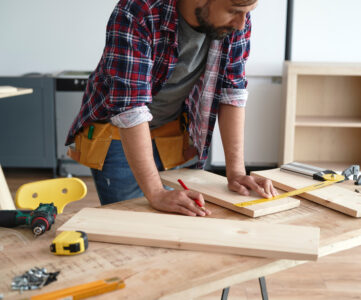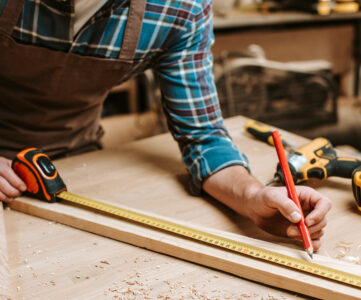Choosing the right tools is key to the success of any DIY project. The debate between hand tools and power tools is a common one. Understanding the basics of each can help you make informed decisions for your next project. Knowing when to use hand tools versus power tools can save you time and effort.
In this guide, we’ll explore the world of hand tools and power tools. We’ll provide you with the knowledge you need to make the right choice for your DIY projects. From the core characteristics of each type of tool to tips on how to select the best tool for the job, we’ve got you covered. Whether you’re a beginner or an experienced DIYer, understanding the differences between hand tools vs power tools is essential for achieving DIY success.
Key Takeaways
- Understand the basics of hand tools and power tools
- Know when to use hand tools vs power tools for your DIY projects
- DIY tool selection is crucial for efficiency and quality
- Hand tools are ideal for precision and control
- Power tools are perfect for large-scale projects and heavy-duty tasks
- Proper tool selection can save you time and effort
Understanding the Basic Differences Between Hand Tools and Power Tools
Choosing the right tools is crucial for DIY success. A hand tools comparison helps decide the best tool for a task. Hand tools, manual and powered by humans, offer precision and control. They’re perfect for small projects or tight spaces.
Power tools for DIY projects use electricity or batteries, making tasks quicker and more efficient. Ideal for large projects or hard-to-handle materials, they’re a must for many tasks. Knowing each tool’s core characteristics is key to making the right choice.
When evaluating tools, consider versatility, speed, and physical effort. For instance, a hand saw excels in precise cuts, while a power saw is better for quick cuts in thick materials. These factors help in deciding between hand and power tools for your projects.
Here are some key points to consider when deciding between hand tools and power tools:
- Versatility: Can the tool be used for multiple tasks?
- Speed: How quickly can the tool complete the task?
- Physical effort: How much physical effort is required to use the tool?
By considering these factors and making a thorough hand tools comparison, you can choose the right tools for your DIY project. Whether using power tools for DIY or hand tools, understanding their strengths and weaknesses is essential for success.
The Essential Hand Tools Every DIYer Should Own
For DIY projects, the right hand tools are crucial. A comparison of hand tools shows some are more vital than others. DIYers need a basic set of tools for various tasks.
Some key hand tools include:
- Hammers
- Tape measures
- Level tools
- Pliers
- Screwdrivers
- Wrenches
These tools are versatile, useful for tasks like hanging pictures or assembling furniture. Knowing how to use each tool is essential for DIY success.
A hand tools comparison highlights each tool’s unique features and uses. Hammers, for example, are not just for driving nails. They’re also for fitting parts together or breaking objects. Tape measures ensure accurate measurements, crucial for project success.
In conclusion, the right hand tools are vital for DIY projects. Understanding each tool’s purpose and use enhances DIY skills and project success.
| Tool | Description | Use |
|---|---|---|
| Hammer | Used for driving nails and fitting parts together | Hanging pictures, assembling furniture |
| Tape measure | Used for measuring distances and sizes | Ensuring accuracy in measurements |
| Level tool | Used for ensuring surfaces are level | Hanging pictures, installing shelves |
Must-Have Power Tools for Home Projects
Having the right power tools is crucial for DIY projects. They make tasks more efficient and effective. Corded tools, like circular saws and drill presses, provide consistent power for heavy-duty tasks.
Cordless tools, such as drills and impact drivers, offer convenience and portability. They’re ideal for projects that require mobility. Some essential power tools for DIY include:
- Drills
- Impact drivers
- Circular saws
- Drill presses
- Routers
- Sanders
Specialty tools, like routers and sanders, are designed for specific tasks. They help achieve professional results. When selecting power tools, consider your projects, available space, and budget.
Choosing the right brand and quality is also key. Popular brands include DeWalt, Makita, and Bosch. Investing in quality tools can elevate your DIY projects.
Successful DIY projects rely on the right tools. Understanding and selecting the appropriate power tools for your needs is essential. This way, you can complete your projects with confidence and precision.
| Power Tool | Description | Price Range |
|---|---|---|
| Drill | A versatile power tool for drilling holes | $20-$100 |
| Impact Driver | A powerful tool for driving screws and other fasteners | $30-$150 |
| Circular Saw | A powerful saw for cutting wood and other materials | $50-$200 |
Hand Tools vs Power Tools: A Comprehensive Comparison
The debate between hand tools vs power tools hinges on the project’s nature, personal taste, and precision needs. Hand tools provide control and are budget-friendly but demand time and physical effort. In contrast, power tools expedite tasks but are pricier and require skill to operate safely.
Assessing hand tools vs power tools involves evaluating cost, efficiency, safety, and project goals. For instance, hand tools excel in fine woodworking for their precision. Yet, for extensive construction, power tools are more suitable. Key considerations include:
- Cost: Hand tools are cheaper upfront, but power tools can be more cost-effective over time.
- Efficiency: Power tools are quicker and more efficient, yet hand tools offer finer control and precision.
- Safety: Both types are safe when used correctly, but power tools necessitate more skill and caution.
The decision between hand tools vs power tools is project-specific and skill-based. Weighing the advantages and disadvantages of each helps individuals choose the right tools for their projects.
Understanding the merits and drawbacks of hand tools vs power tools empowers users to optimize their tool usage and succeed in DIY endeavors.
| Tool Type | Cost | Efficiency | Safety |
|---|---|---|---|
| Hand Tools | Less expensive | Less efficient | Safe if used properly |
| Power Tools | More expensive | More efficient | Safe if used with caution and skill |
Cost Analysis: Investment and Long-Term Value
Cost is a key factor in DIY tool selection. Power tools often have a higher initial cost than hand tools. Yet, their long-term benefits are significant. They save time and boost productivity, making them a worthwhile investment.
When choosing DIY tools, it’s vital to balance initial costs with long-term gains. For instance, a power drill might be pricier than a hand drill. Yet, it completes tasks faster and with greater precision. This is crucial for those tackling multiple projects.
- Initial purchase cost
- Maintenance expenses
- Return on investment
By examining these aspects, DIY enthusiasts can make wise choices. They ensure they’re getting the most value for their money.
The smartest DIY tool selection hinges on understanding each project’s needs. Choosing the right tools leads to professional-grade results. This way, DIY enthusiasts maximize their tool’s value.
| Tool Type | Initial Purchase Cost | Maintenance Expenses | Return on Investment |
|---|---|---|---|
| Hand Tools | Lower | Lower | Lower |
| Power Tools | Higher | Higher | Higher |
Safety Considerations for Both Tool Types
When comparing hand tools vs power tools, safety is paramount. Both can be dangerous if mishandled. Hand tools might lead to cuts, bruises, or strains. On the other hand, power tools carry risks like electrical shock, entanglement, and projectiles.
To ensure safe handling of hand tools vs power tools, adhering to the manufacturer’s guidelines is crucial. Protective gear is a must. Regular tool maintenance is also vital to prevent accidents. Here are some essential safety tips:
- Wear protective gear, including gloves, safety glasses, and a dust mask
- Follow the manufacturer’s instructions for each tool
- Regularly inspect tools for damage or wear
- Keep work areas clean and well-lit
By following these precautions, you can significantly reduce the risks of hand tools vs power tools. Remember, safety is a collective responsibility. It’s your duty to protect yourself and others in the workplace.
Choosing the Right Tool for Specific DIY Tasks
When tackling DIY projects, the right tools are essential. Often, a mix of hand tools and power tools is needed. It’s vital to know what each task requires for success. A comparison of hand tools can guide DIYers in choosing the right tools for their tasks.
Woodworking projects demand precision and efficiency. Hand tools like chisels and hand saws are perfect for detailed cuts. In contrast, power tools such as table saws and drill presses excel in making large cuts and drilling efficiently. Home repairs, on the other hand, need versatility. Both hand tools and power tools are crucial for various tasks.
When selecting tools, consider a few key factors:
- Precision: Hand tools are ideal for tasks needing precision, like furniture assembly.
- Efficiency: Power tools are better for tasks requiring speed, such as woodworking.
- Versatility: Using both hand tools and power tools can offer the flexibility needed for different tasks.
Comparing hand tools can help DIYers make better choices for their projects. By matching tools to task requirements, they can ensure a successful outcome and avoid frustration.
The secret to selecting the right tool lies in understanding each task’s specific needs. With a good hand tools comparison, DIYers can confidently take on a variety of projects.
| Task | Recommended Tools |
|---|---|
| Woodworking projects | Table saws, drill presses, chisels, hand saws |
| Home repairs | Hammer, screwdrivers, wrenches, power drill |
| Furniture assembly | Screwdrivers, wrenches, hand saws, clamps |
Maintenance and Care Tips for Longevity
Proper maintenance and care are crucial for the longevity and performance of both hand tools and power tools. When selecting DIY tools, it’s essential to consider their maintenance needs. Regular cleaning, storage, and sharpening of hand tools can extend their lifespan. For power tools, regular lubrication, cleaning, and checking for wear and tear are key.
A well-thought-out DIY tool selection can greatly impact project success. By choosing the right tools and caring for them, individuals can keep their tools in top condition. This ensures they’re ready for the next DIY endeavor. Key maintenance tips include:
- Storing tools in a dry, secure location to prevent damage and loss
- Following the manufacturer’s maintenance instructions for power tools
- Sharpening hand tools as needed to maintain their effectiveness
By integrating these maintenance and care tips into their DIY routine, individuals can enjoy their tools for longer. Proper care and maintenance also prevent accidents and ensure a safe workspace. Thus, dedicating time to maintain and care for tools is vital for any successful DIY project.
Environmental Impact and Energy Efficiency
When evaluating hand tools vs power tools, it’s crucial to consider their environmental impact and energy efficiency. Hand tools are often more eco-friendly since they don’t require electricity or batteries. This makes them an excellent option for those aiming to lower their carbon footprint.
On the other hand, power tools have evolved to be more energy-efficient. Many modern models are designed to use less energy. Some even incorporate renewable energy sources, such as solar power, for charging. Opting for energy-efficient power tools can significantly reduce your environmental impact.
Here are some key considerations for the environmental impact of hand tools vs power tools:
- Durability and longevity: Select tools that are built to last to reduce waste and the need for frequent replacements.
- Energy efficiency: Seek out power tools with energy-saving designs and consider using renewable energy for charging.
- Sustainability: Choose tools made from sustainable materials whenever possible.
By examining the environmental impact and energy efficiency of hand tools vs power tools, you can make choices that reflect your values and reduce your carbon footprint. Whether you prefer hand tools or power tools, always prioritize sustainability and energy efficiency.
Conclusion: Making the Right Choice for Your DIY Projects
The decision between hand tools and power tools for DIY projects is crucial. Power tools bring speed and efficiency, while hand tools offer a more personal touch. It’s essential to understand the pros and cons of each for DIY tool selection and success in your projects.
Assess your needs, project specifics, and personal taste. For detailed work, hand tools might be ideal. Yet, power tools are better for bigger tasks or those needing more force. Balancing tool choice for each task can enhance your DIY work’s quality and durability.
The DIY journey is about more than tools; it’s about knowledge, patience, and practice. With the right tools and mindset, you can explore endless creative possibilities. This will help you transform your spaces with confidence and pride.






